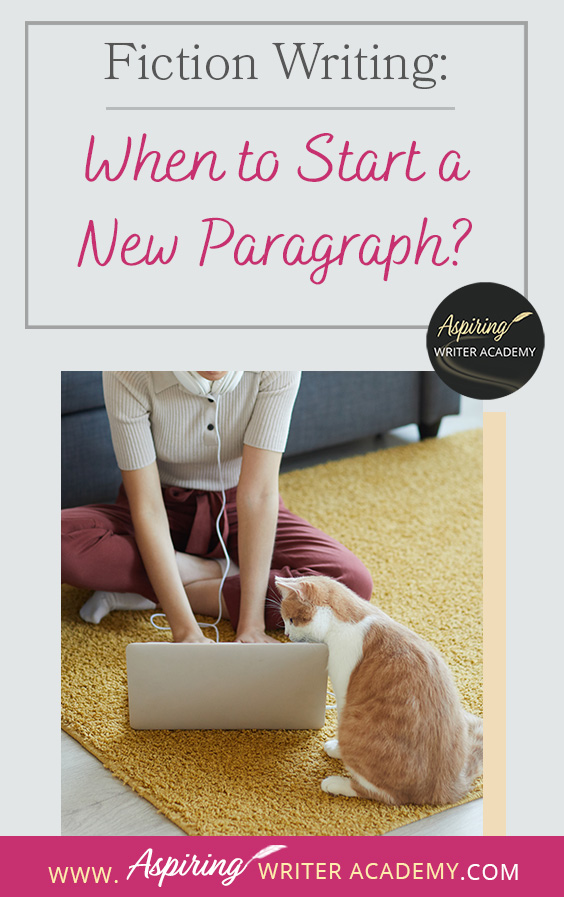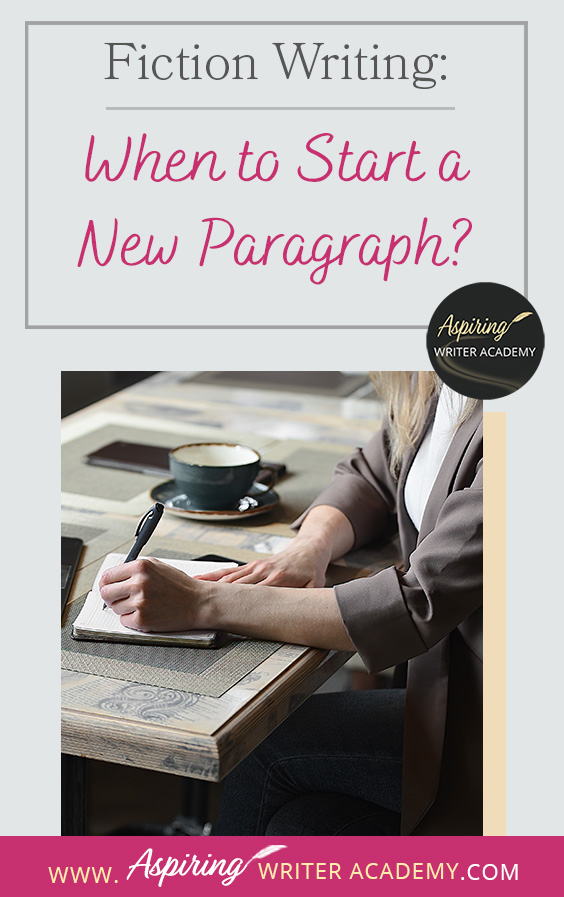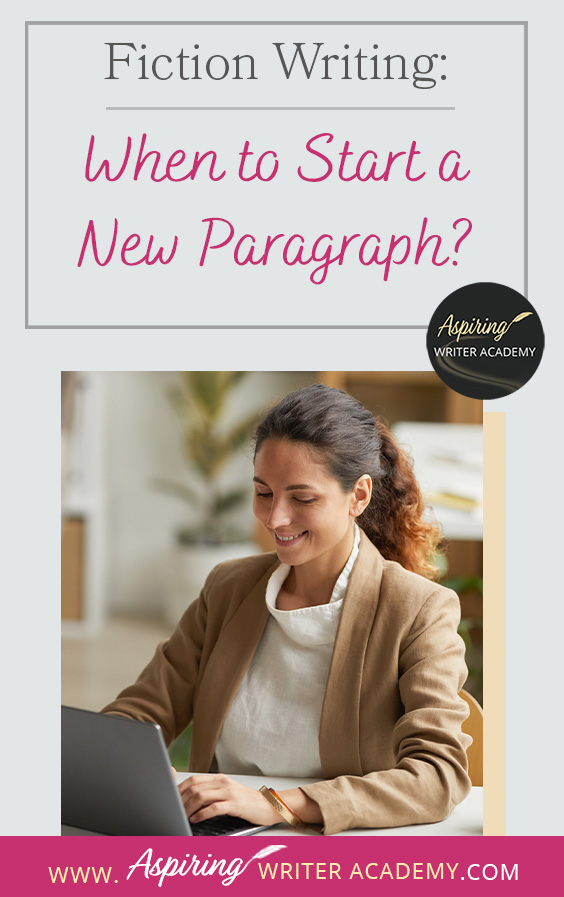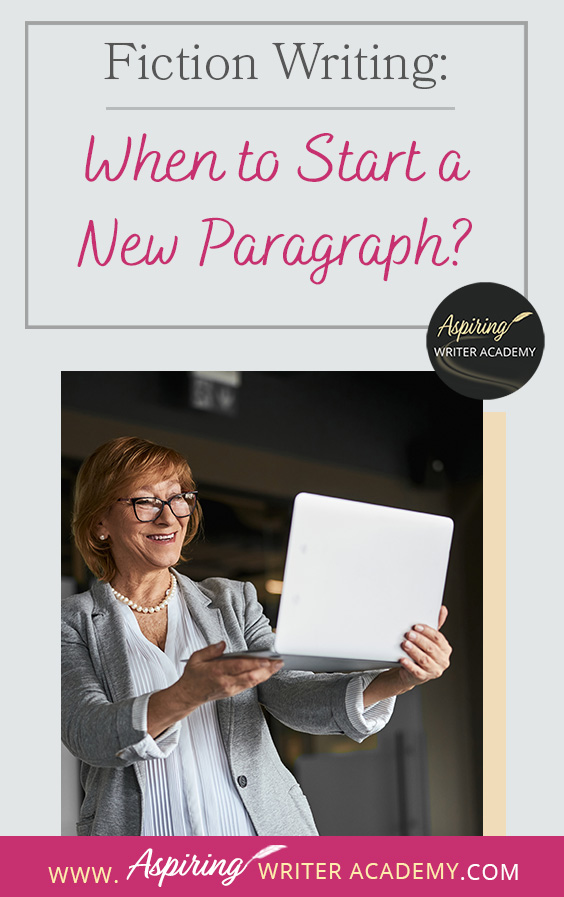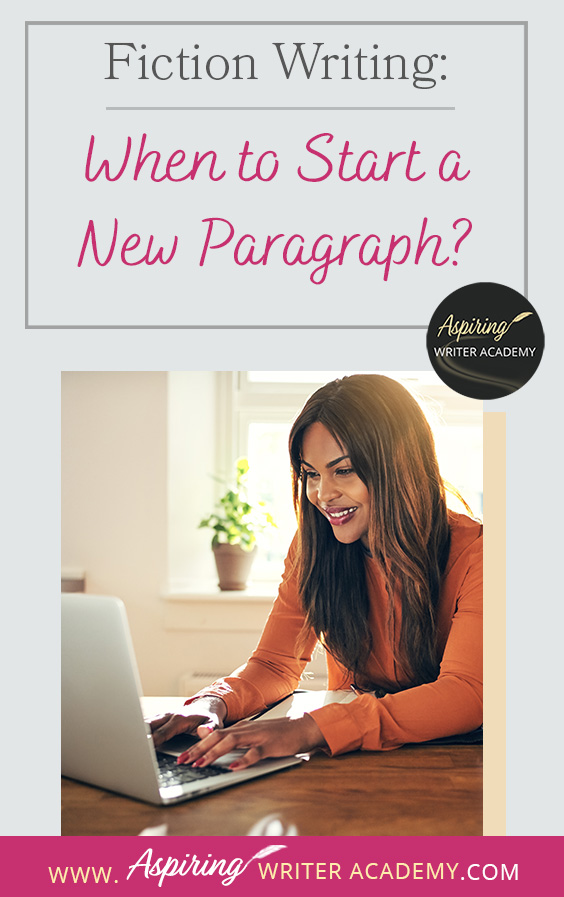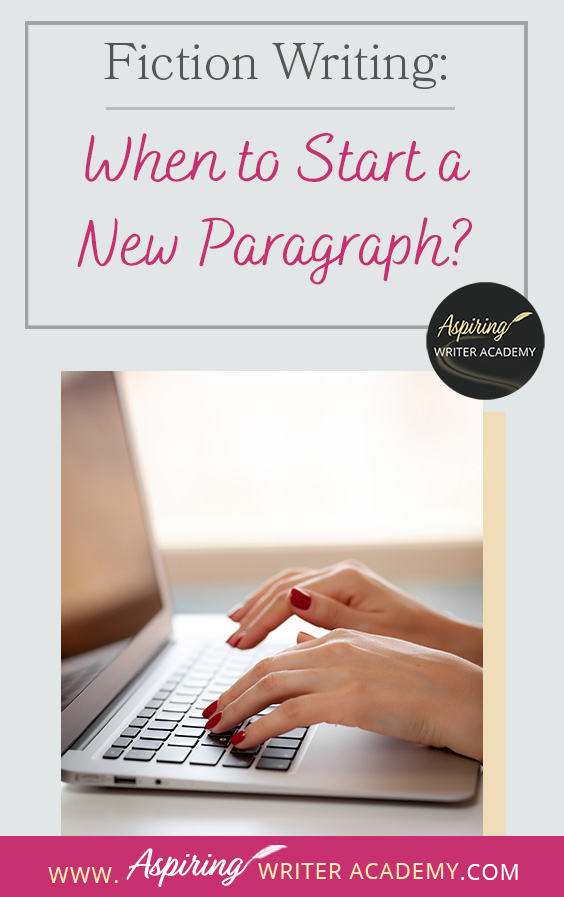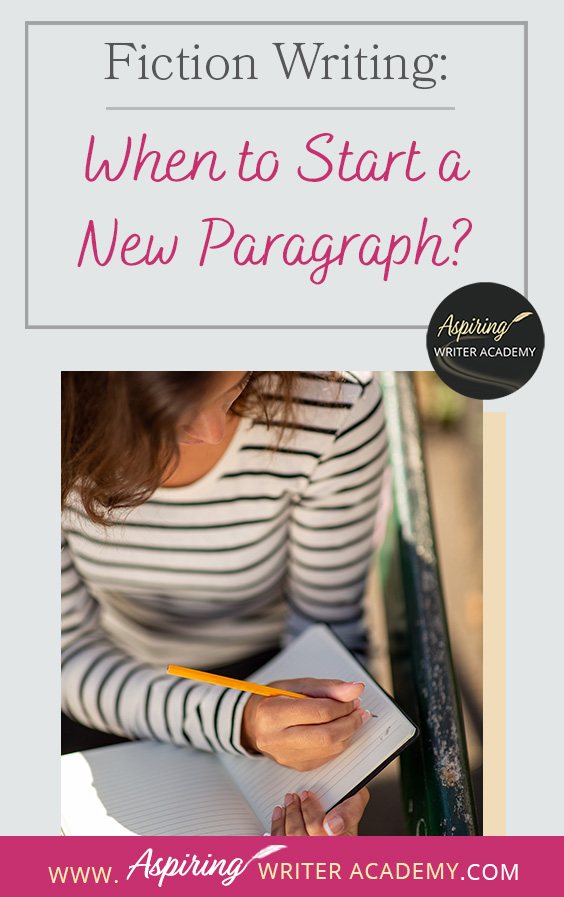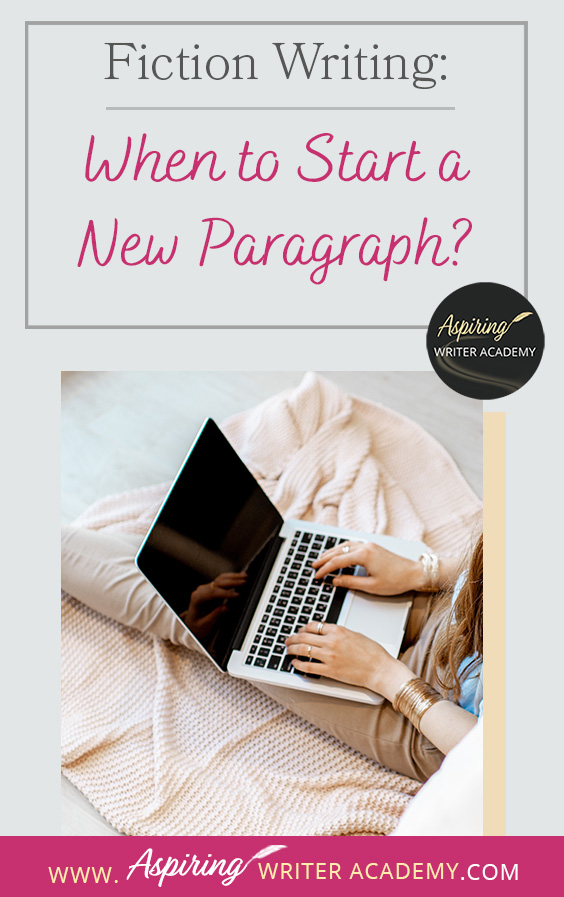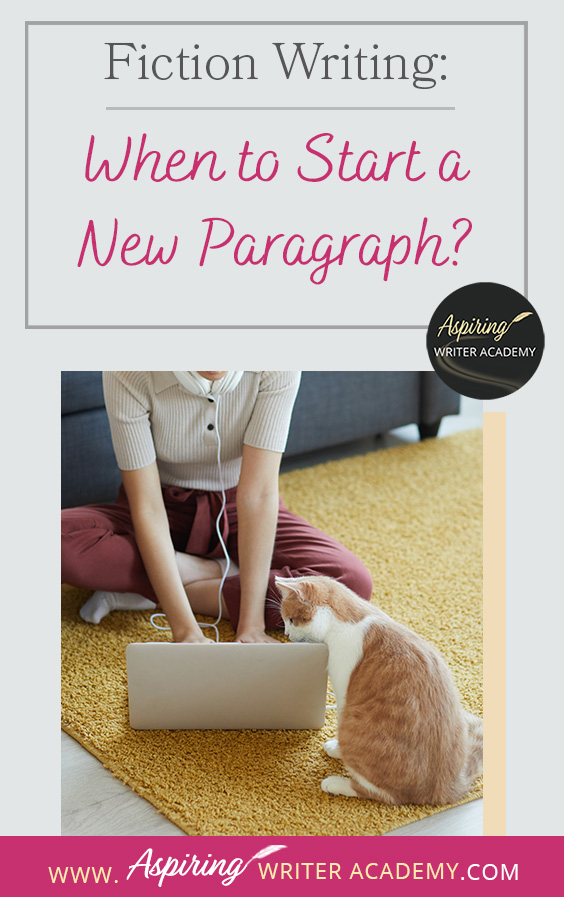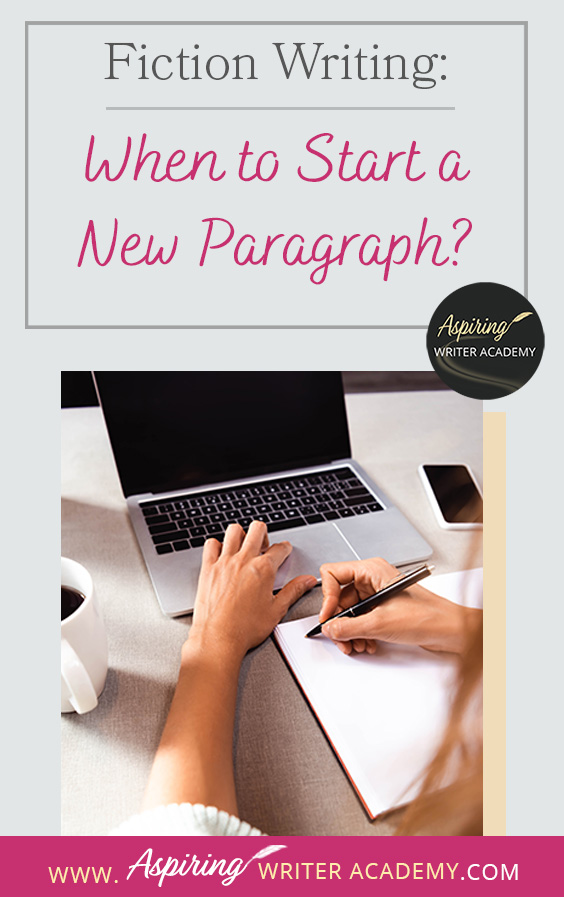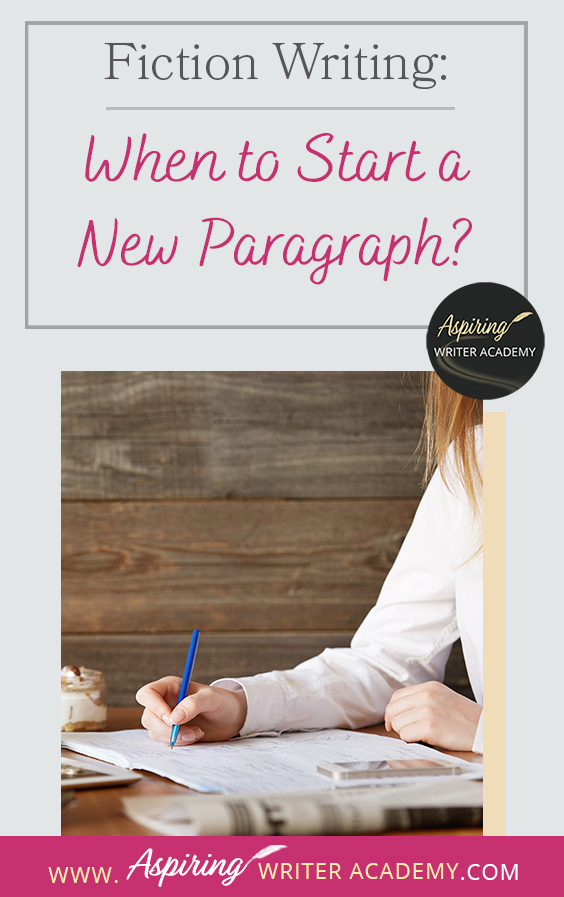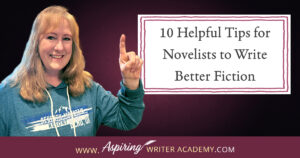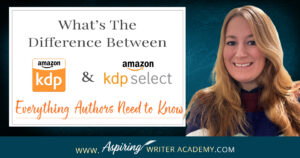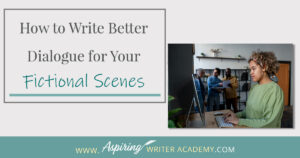Fiction Writing: When to Start a New Paragraph?
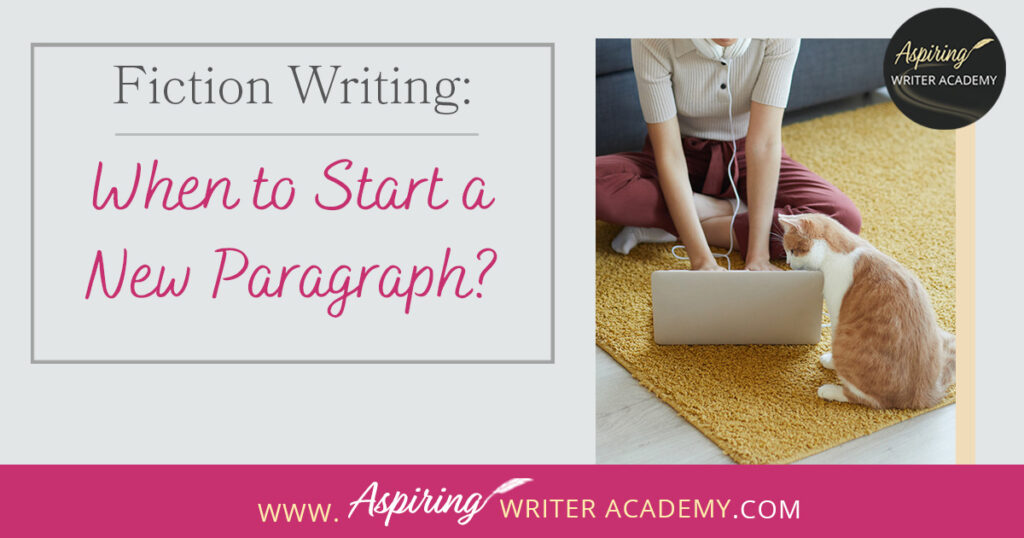
Do you know when to start a new paragraph in your fictional novel? Did you know that paragraphing can be different for popular fiction than if you are writing non-fiction, literary fiction, or a story for English composition class? That is because popular (or genre fiction) is designed to hook the reader and entertain, often by utilizing stylistic effects.
In Fiction Writing: When to Start a New Paragraph? we discuss 10 times you should be indenting the text for maximum story impact.
First, what exactly is a paragraph?
A paragraph is a grouping of related sentences that focus on a single topic. One paragraph in a story may focus on dogs, while another focuses on the weather. Each new paragraph starts with indented text from the left margin: A half inch (0.5 in.) or 1.25 centimeters (1.25 cm).
Note: You should have already set the margins for your manuscript to 1 inch (2.5cm) on all four sides of the document. This is usually the default setting in Microsoft Word.
However, when writing popular fiction, there may be times when you have a new indented paragraph for just one sentence, or perhaps even one word for special emphasis or effect. You should have a new paragraph in dialogue each time a different character speaks or performs a new action. But what does this really look like on the written page?
Follow along as we show you some examples and discuss 10 times to start a new paragraph in your fictional novel so that you can break up big blocks of boring text and write with more confidence and clarity.
Fiction Writing: When to Start a New Paragraph?
1) At the Start of Every New Scene or Chapter
Some authors do not indent the first paragraph of each chapter in their novel but then indent every paragraph afterward. Others start their chapters with the traditional 0.5 inch or 1.25 cm indentation. If you are writing for a traditional publisher, you can ask which style they prefer. For those who are self-publishing the choice is up to you.
However, each new scene in your story should definitely start with a new indented paragraph. You may be thinking: How do I know if I am starting a new scene?
In a new scene the point-of-view (POV) character starts action on a new mini goal, wrestles with at least 3 points of conflict, and learns whether he is able to achieve this scene mini goal or not. The character must then make a choice between two viable options for his next course of action. This action becomes the character’s next mini goal.
This may be the next scene in your novel or you may choose to switch to the viewpoint of another character and start a new scene—which will start with an indented paragraph.
For more help with Scene & Sequel visit:
https://www.aspiringwriteracademy.com/scene-sequel-the-secret-to-plotting-an-epic-novel/
2) Whenever There is a New Setting
If your characters move to a different location or setting, this is a significant change in your story and should start with a new indented paragraph.
We are not talking about your character moving across the room to sit on the couch, but if your character moves from one room of the house to another, then yes, you should probably start a new paragraph when he enters the new room. Especially because the new room probably has a new purpose. The focus of the scene or dialogue between characters may also now be different and there should be a description of this new room and the surrounding items that the character can now interact with.
New settings could also include a character who leaves home and arrives at work. A new setting may also signify a new scene or chapter. However, you could have a character briefly visit multiple settings in a single scene.
Your character may briefly change location if he is searching for something or is a detective investigating a crime scene or interviewing multiple witnesses. In this case, each new mini-location of the scene (parts of the larger setting) or each new mini-interview would warrant a new paragraph.
3) If Time Jumps Forward or Backward
Start a new paragraph if the story jumps forward in time.
If you have a paragraph where your character just decided to fly to another country and then suddenly skip the story to a segment where the character is boarding the plane three weeks later, you need to start a new paragraph.
In addition to a jump forward in time, this is also probably a change in setting and may be the start of a new scene or chapter. To further emphasize that this is a new scene with the same character, it is also advised to drop down a double space between scenes.
Example:
She set her fork down on the dinner table, her decision made. She was going to quit her job, fly to Italy, and enjoy wherever life took her.
Three weeks later, she stepped off the plane in Rome. The attendant at the baggage claim helped her find her suitcase and within the hour she was able to secure transport to her aunt’s picturesque Italian villa.
Start a new paragraph at the beginning of a flashback.
This is because you are briefly leaving the scene at hand to travel (change of location or setting) back to a time in the past (a different scene), even though it is all in the point-of-view character’s mind.
Example:
Carol’s thoughts drifted back to the time she fell off a skateboard and skinned her knee. She’d only been six years old. The scab took three weeks to heal, and she never wanted to attempt skateboarding again even though her older brother tried to bribe her.
Or
The troubled look he sent her way reminded her of the way he used to look whenever something went wrong back in high school. He was considered a ‘bad boy’ back then, always getting detention from Mr. Hollander for fighting with the infuriatingly egotistical captain of the football team.
4) When Switching POV (point-of-view)
Start a new paragraph (and drop the text with a double space or center a triple asterisk) to indicate to the reader that you are switching from the point-of-view of one character to another.
Whenever you change the POV in your story, you are shifting the focus of the story. You may also be starting a new scene or chapter, changing locations, or jumping forward or backward in time.
Example:
Doug eyed the brunette beauty before him, noticing the way the corner of her mouth twitched as she spoke. Could he trust her?
* * *
Francesca fiddled with the silk tassels hanging off the end of purse, her hopes plummeting with every passing second. She doubted Doug would help her. His look of suspicion the night before when she’d broached the subject had made her feel all queasy inside.
5) In Dialogue: Each Speaker = New Paragraph
The number one rule of dialogue is to start a new paragraph every time you have a new speaker.
Do not combine two characters’ dialogue into the same sentence or the same paragraph. Each character gets their own line, their own indented paragraph, no matter how brief.
Example:
“What do you think about using coconut oil instead of olive oil in this recipe?” Lousia asked.
Phillipe shook his head. “It will change the taste of the bread.”
“It might taste better,” Louisa insisted. She gave him a smile to help influence his final decision.
“No.” Phillipe narrowed his gaze. “This is my restaurant, and we will continue to serve the same bread as my father when he owned the place.”
One of the servers, Charles, opened the door to the kitchen and poked his head through. “Do either of you know when the next batch of bread will be ready? Customers are waiting!”
Also be careful that you do not ‘bury the dialogue’ within the paragraph.
Keep the dialogue speech to the front or the end of the paragraph. Do not place lines of action or description both before and after the speech but keep it to one end so the character’s speech stands out to the reader.
For more help with dialogue visit:
https://www.aspiringwriteracademy.com/novel-writing-tips-dont-bury-the-dialogue/
6) To Separate a Character’s Dialogue from Another’s Action/Reaction
You should also start a new paragraph to separate one character’s speech from an action or reaction taken by another character.
Give each character their own paragraph to keep the story clear for the reader. When you combine different characters actions/reactions and dialogue the text can become confusing.
Example:
Bad:
Sarah smiled and mimicked the monkey swinging from the branches of the tree which made me laugh and unfortunately, I spilled my soda. Larry shot me a look that said he thought I over-reacted, and I challenged, “Do you think you could do that?”
Better:
Sarah smiled and mimicked the monkey swinging from the branches of the tree.
I laughed and unfortunately, I spilled my soda.
Larry shot me a look that said he thought I over-reacted.
“Do you think you could do that?” I challenged.
Or
Bad:
“How could you be so stupid?” he yelled, and tears rolled down my face. How dare he talk to me like that! He had no idea what I had been through the last few days, no idea what I was dealing with while he sat lazily on the couch.
Better:
“How could you be so stupid?” he yelled.
Tears rolled down my face. How dare he talk to me like that! He had no idea what I had been through the last few days, no idea what I was dealing with while he sat lazily on the couch.
7) For Each New Character’s Action/Reaction
Similar to separating each character’s dialogue from one another, you might also start a new paragraph for each character’s actions and reactions. Especially in a fight scene, where it is important to show which character is doing what.
If the action and reaction segments by two characters is short, you may want to combine them in one sentence if there is no dialogue attached.
Example:
Tom shot Mary a derisive look and she punched him in the arm.
However, with longer paragraphs with many stimulus-response back and forth actions and reactions that include longer description, it is better to give each character their own paragraph. This also provides clarity for the reader.
Example:
Tom didn’t like the way Mary spoke to him and shot her a derisive look. Who did she think she was?
Mary’s frustrated frown deepened as she balled her tiny fingers into a fist and punched him in the arm.
Flinching, Tom turned toward the door to get away from her.
8) Shift of Focus: Change of Topic, Thought Pattern, or New Event
It is also a good idea to start a new paragraph whenever there is a shift of focus in the story. In dialogue or in the character’s thought patterns, if there is a change of topic that changes the flow, start a new paragraph.
For example, if two female characters are talking about how to clean the living room carpet and then switch to talking about the guy their friend invited over for dinner, the change in topic should start with a new paragraph.
If a character is thinking about painting the kitchen yellow and then their thoughts change to thoughts of what to wear to an upcoming party, the switch warrants a new paragraph.
Introduction of a new event: If something happens that changes the course of the scene, start a new paragraph.
For example, if two people are having a conversation and then a new character enters the room. Or if a group of people are arguing over who should inherit their grandfather’s house and then the roof above them begins to collapse. The focus has changed.
If you are writing blocks of description, start a new paragraph every time the focus shifts to describe something new, or zooms in on something important.
Example:
At first glance, Steve didn’t think the old farmhouse held anything of interest. The dull, gray-colored couch and matching recliner had been covered in dust. Cobwebs stretched down from each corner of the old windows. At the far end of the room, a simple square table sat off to the side.
Then he spied a bright blue object sitting low on the bookshelf beneath the window ledge and his pulse quickened as he stepped forward. What was it?
9) To Break up Big Blocks of Text for More White Space
Sometimes it is necessary to start a new paragraph just to create more ‘white space’ on the page. Big blocks of black text can make a reader’s eyes grow wearisome. The more open, white space on the page, the better. It also makes your story easier to skim, which increases the pacing and keeps the reader invested.
If the text has no dialogue or multiple character reactions, such as when you are in one character’s point-of-view and you need a few paragraphs of description, look to see where you might break up the text. Try to reduce each paragraph to only two or three sentences.
It is also important to break up large blocks of dialogue if a character is giving a speech. Either paragraph multiple times or have another character make a comment or ask a question to interrupt the speech and create more ‘white space.’
Also, if your character is alone, you can paragraph different parts of the narrative to create more ‘white space’ on the page. You can start a new paragraph when he speaks with dialogue, or has a direct thought in italics, or an indirect thought, or initiates a new action or has an involuntary reaction or makes an observation requiring description. While some of these may be combined into one paragraph, you may also choose to start a new paragraph with any of these elements to break up large blocks of text.
10) For Pacing & Special Effect
Paragraphing can control story pacing.
New paragraphs create more open space on the page, which allows the reader to skim your pages quicker. This increases the pacing and grabs the reader’s interest.
As an author, you have the power to manipulate the pacing of your story. If you want to slow things down for your reader to catch their breath, create longer paragraphs. If you want to quicken the pace during a fight or a riveting chase scene, use short sentences and paragraph almost every other line.
Paragraphing can also be used for special effects.
This is especially useful for delivering ‘hook’ lines at the end of a scene or chapter. Just like when a comedian waits to deliver the punchline of a joke (for dramatic effect), you might want to occasionally drop down a one-word sentence or short ‘hook’ sentence to add humor, hint at events to come, create tension, or turn the scene into a cliffhanger.
The idea is that this will make the reader so eager to find out what happens next, that he or she will need to continue reading the story. Writing a story that your readers ‘can’t put down’ is a good thing.
Example:
Ryan couldn’t figure who could have been vindictive enough to salt his hay fields and kill off his harvest. Now all the soil would need to be turned up before he could replant. Surely his old neighbor, Meryl, wouldn’t mind if he borrowed an attachment for his tiller.
Walking across the driveway, he headed into the barn and looked around. He knew Meryl kept most of his larger tools close to the door on the right.
Yep. There sat the tiller attachment.
Except Merle had left a shiny new wrench lying on top of it. Ryan picked up the wrench and was on his way to return it to the cubby where the smaller tools were kept in the back when a flash of white caught his eye. He turned his head to get a better look and saw several white bags stacked in the corner.
Rock salt.
Another Example:
“Dad wasn’t exactly supportive when I told him I was making jewelry,” Bree confided.
“Is he ever?” Delaney countered.
No. Their father had never been supportive of any of his children’s ideas if they didn’t align with his own.
Bree shared a brief smile with her sister and sighed. She dreamed that one day… just once… her father would look at her with pride.
And tell her he believed in her.
Another Example:
As the Gator drew closer, she realized it was Mrs. Owens who sat in the driver’s seat. Donna didn’t like her much, but it was obvious from the taut expression on her face that the woman was on an urgent mission.
Had Mr. and Mrs. Owens found her father?
Do you see how the last line in each example was dropped down into its own new paragraph to create a ‘hook’ for the end of the scene?
When to Start a New Paragraph in Fiction Recap:
1. At the Start of Every New Scene or Chapter
2. Whenever There is a New Setting
3. If Time Jumps Forward or Backward
4. When Switching POV (point of view)
5. In Dialogue: Each Speaker = New Paragraph
6. To Separate a Character’s Dialogue from Another’s Action/Reaction
7. For Each New Character’s Action/Reaction
8. Whenever There is a Shift of Focus: Change of Topic, Thought Pattern, or New Event
9. To Break up Big Blocks of Text for More White Space
10. For Pacing & Special Effect
We hope you have enjoyed Fiction Writing: When to Start a New Paragraph? and that you have learned when it is best to indent and start a new paragraph in your fictional novel.
If you have any questions or would like to leave a comment below, we would love to hear from you!
If you like more help developing your story, you may wish to download our Free Brainstorming Your Story Idea Worksheet
Do you find it difficult to create compelling antagonists and villains for your stories? Do your villains feel cartoonish and unbelievable? Do they lack motivation or a specific game plan? Discover the secrets to crafting villains that will stick with your readers long after they finish your story, with our How to Create Antagonists & Villains Workbook.
This 32-page instructional workbook is packed with valuable fill-in-the-blank templates and practical advice to help you create memorable and effective antagonists and villains. Whether you're a seasoned writer or just starting out, this workbook will take your writing to the next level.
We Believe All Authors Can Aspire to Take Their Writing to the Next Level!
Our Goal for Aspiring Writer Academy is to help people learn how to write quality fiction, teach them to publish and promote their work, and to give them the necessary tools to pursue a writing career.

ENTER YOUR EMAIL BELOW
TO GET YOUR FREE
"Brainstorming Your Story Idea Worksheet"
7 easy fill-in-the-blank pages,
+ 2 bonus pages filled with additional story examples.
A valuable tool to develop story plots again and again.
Other Blog Posts You May Like
How to Use Framing Techniques in Your Fictional Novel
How to Delete Dialogue Tags (He said /She said) in Fiction Writing
Novel Writing Tips: Don’t Bury the Dialogue!
Fiction Writing: How to Write Compelling Dialogue
12 Quick Tips to Write Dazzling Dialogue
Top 10 Fiction Edits to Make Your Story Better
How to Use Framing Techniques in Your Fictional Novel
How to Delete Dialogue Tags (He said /She said) in Fiction Writing
How to Manipulate Pacing to Increase the Intensity of Your Scenes in a Fictional Novel
Fiction Writing: The 3 Different Levels of Editing
5 Reasons Your Writing Sucks! (And How to Fix It)
Novel Writing Tips: Don’t Bury the Dialogue!
Fiction Writing: Critique Group Etiquette & Warning Signs of a Good Group Gone Bad
Fiction Writing: How to Find a Critique Partner/Group
Creative Writing: 5 Ways to Strengthen a Weak Fictional Character
How to Create a Deadline for Your Fictional Novel
How to Create S.M.A.R.T. Goals to Keep Your Writing on Track
How to Write the Midpoint of Your Novel (and Avoid a ‘Saggy Middle’)
20 Items to Bring to Your First Writer’s Conference
101 Quick Writing Tips for Authors and Writers
The Money-Making Author Mindset: Strategies for Financial Growth and Success for Writers

is a multi-published author, speaker, and writing coach. She writes sweet contemporary, inspirational, and historical romance and loves teaching aspiring writers how to write quality fiction. Read her inspiring story of how she published her first book and launched a successful writing career.

